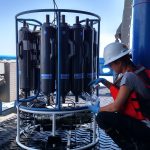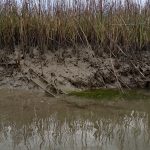Gifford Lab
The vast global ocean is teaming with microbial life. Each liter of seawater contains over 1 billion bacterial cells, such that even given their small size (less than 1 µm long, or a millionth of a meter), bacteria are the biochemical engines of the ocean, controlling the fate of energy and essential elements such as oxygen, carbon, nitrogen, and phosphorus as they are transported into the ocean, around the globe, and eventually back into the atmosphere or buried deep in the seafloor.
In recent years, the genomic revolution has revealed that not only are marine bacteria incredibly abundant, but that they are also incredibly diverse. Within that liter of seawater are thousands of different types of bacteria that contain millions of genes. What are all these cells doing? How do they function in the ocean environment? How do the genes they contain, and the resulting processes they ultimately encode, influence the ecology and biogeochemistry of the ocean?
Our group examines the molecular biodiversity found in microbial communities and the role bacteria play in shaping ocean chemistry and ecology. We use genomics, expression analysis, and rate measurements both in the field and the laboratory to investigate fundamental questions about how the ocean’s smallest inhabitants drive some of its most important processes.
For an overview of our current projects see the RESEARCH page and NEWS (coming soon) for the latest lab activities. You can also find PUBLICATIONS from past work and a list of our current lab members (PEOPLE. If you’re interested in working with the lab please see the CONTACT page.
CURRENT RESEARCH
 EXPORTS: Coupling omics technologies to understand carbon production and removal at the oceans surface
EXPORTS: Coupling omics technologies to understand carbon production and removal at the oceans surface
EXport Processes in the Ocean from Remote Sensing (EXPORTS) is a large-scale NASA-led field campaign that will provide critical information for quantifying the export and fate of carbon using satellite observations and state of the art ocean technologies. The overarching goal is to understand how the carbon makes it to the twilight zone and deep ocean interior, and how long it stays there, which is vital to understanding present and future ocean ecosystems and global climate. (http://oceanexports.org). We are determining the marine microbial community composition through DNA sequencing as well as sequencing of environmental RNA to determine gene expression that can be used to infer the physiological status of the microbial plankton community. This information is then coupled with rate measurements to allow for an unprecedented ability to examine how the form and function of upper ocean microbial ecosystems shape the carbon export potential.
 Bacteria as Biosensors of the Coastal Carbon Pool
Bacteria as Biosensors of the Coastal Carbon Pool
Bacterial processing of dissolved organic carbon (DOC) mediates the flux of gigatons of carbon in the ocean, yet a significant hurdle to incorporating bacterial metabolism into ocean models is the inability to quantify the DOC substrates supporting bacterial metabolism and their transformation. Metatranscriptomics (sequencing of community mRNAs) has the potential to be a sensitive method for surveying bacterioplankton responses to the DOC pool and making insights into its composition but is currently limited by insufficient knowledge as to how transcriptional patterns relate to substrate availability. This project will identify carbon substrates supporting microbial metabolism and their transformation in estuarine-coastal ecosystems by elucidating the relationships between transcript abundances and carbon substrate availability. It aims to bridge the gap between model organism and environmental -omic studies by creating quantitative inventories of transcripts in response to defined substrates, and then using these calibrated transcriptional signals to interpret environmental DOC bioassays and metatranscriptomes.
 The Galapagos Marine Microbiome
The Galapagos Marine Microbiome
We have established the Galápagos Archipelago as a natural laboratory to numerically determine the composition, functional capabilities, and activities of marine bacterioplankton with their environmental drivers using quantitative metagenomics. Well known for contributing to the understanding of terrestrial macroecology, the Galápagos archipelago also harbors a set of diverse marine ecosystems in close proximity due to the confluence of several major ocean currents over a dynamic seafloor topography. We are leveraging this habitat diversity to numerically determine how the abundances of microbial taxa are shaped by physical factors such as upwelling, wind-driven island mass effects, the organic chemistry, and dominant phytoplankton types. Further, we are investigating how the archipelago marine environment and microbial communities undergo substantial shifts during El Niño events. This work is provided a completely quantitative framework linking microbial structure and environmental drivers for incorporation into biogeochemical and ecological models of their role in the carbon cycle.
